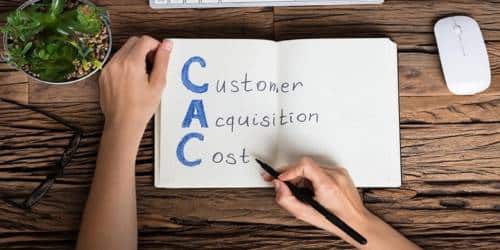The world’s finest marketers help their companies develop over time. However, marketers appear to go through bouts of collective lunacy where we lose sight of the ‘long term’ half of the equation and begin chasing growth at any cost. If you want to grow your customer base while still making a profit, you must consider customer acquisition cost (CAC). In this post, we give you a quick and comprehensive rundown of how to calculate an average customer acquisition cost (CAC) using its formula and also a clear comparison between customer acquisition cost vs lifetime value. Let’s get started!
What is Customer Acquisition Cost (CAC)?
Customer Acquisition Cost, or CAC, is the amount of money spent by a company to attract new customers. CAC is a critical business statistic that represents the overall cost of sales and marketing efforts, as well as property or equipment, required to persuade a client to purchase a product or service.
Analyzing CAC alongside Lifetime Value (an estimate of how much revenue an account will bring in over its lifetime by continuing to purchase or subscribe for a longer period of time) or Monthly Recurring Revenue (the measurement of revenue generation by month) is a common way to determine whether or not a company is operating efficiently.
Why does CAC Matter?
CAC measures the success of your marketing and sales campaigns. Your marketing and sales teams devote a significant amount of time, effort, and resources to acquiring new customers and increasing client retention. Customer acquisition cost is simply one essential performance measure that your company must monitor to assess how effective your efforts are.
Once you know how much it costs to acquire a customer, you can start planning ways to cut those costs, thus increasing your return on investment (ROI). For example, if you want to send a sales email that converts, you may track the efficacy of your campaign and A/B test various elements to find methods to cut costs.
It is less expensive to keep clients than it is to find new ones. So, while CAC is an important indicator, you should also consider other elements that may affect your bottom line, such as customer retention.
How do I Calculate Customer Acquisition Cost?
It is really simple to calculate your customer acquisition cost. Simply divide the expenditures associated with obtaining additional customers (marketing expenses) by the number of consumers acquired to calculate the customer acquisition cost:
#1. Select a time period for calculation.
The first stage in calculating your client acquisition cost is determining the time period under consideration (month, quarter, or year). This will assist you in narrowing the scope of your data.
#2. Determine your CAC.
Next, total your marketing and sales expenses and divide them by the number of new clients gained throughout the period. The result value should be the anticipated cost of obtaining a new customer for your firm.
Below is the formula that you can use to calculate customer acquisition cost for your business.
Customer Acquisition Cost Formula
You can calculate customer acquisition cost by using this Customer Acquisition Cost formula:
Customer Acquisition Cost = Cost of Sales and Marketing divided by the Number of New Customers Acquired.
Assume your company spends $500K on sales and $300K on marketing. Furthermore, during the previous fiscal quarter, your company acquired 800 new clients. As a result, calculating the CAC for your company, the cost to acquire a customer for that quarter would be $1K ((500K + 300K)/800= 1K).
#3. Compare your CAC to key business metrics.
After you’ve computed CAC for your organization, you can compare it to other crucial business KPIs. This will provide you with valuable insights into your marketing, sales, and customer service campaigns.
Types of Costs to Include in a Customer Acquisition Cost Formula
If you’re not sure what your “cost of sales and marketing” is, consider the following charges to understand the types of cost to include in a customer acquisition cost formula.
#1. Ad Spend
Ad spending is the amount of money you spend on advertisements. Advertising is a terrific technique for certain businesses to gain new clients. Ad campaigns must resonate with your target audience in order to be effective. If you’re unsure whether you’re getting a decent return on a marketing effort, you can evaluate its worth by dividing the revenue generated by advertising by the amount you spent on that campaign.
#2. Employee Salaries
Excellent employees are always worthwhile investments. So, if you believe the cost is excessive, pay particular attention to how you approach it. various than implementing salary cuts or layoffs, there may be various ways to save money on salaries. Chatbots and marketing automation, for example, can enhance your team’s workflow and boost your company’s total efficiency.
#3. Creative Costs
Creative costs are the expenses incurred when creating content. This could be money spent on recruiting new employees to help your firm grow, or it could be money spent on lunch for your team meeting. All of these expenses are accounted for while creating content.
#4. Technical Costs
The technology used by your marketing and sales team is referred to as technical costs. A technical cost might be if you buy a reporting instrument that follows the progress of your open deals.
#5. Publishing Costs
Publishing expenses are incurred when your marketing effort is made available to the general public. This could be money spent on TV airtime, paid social media ads, or a newspaper or magazine advertisement.
Lifetime Value vs Customer Acquisition Cost Comparison
A customer’s lifetime value (LTV) is one measure to consider in relation to customer acquisition cost. LTV is the expected revenue generated by a single client over the course of their engagement with a company.
To calculate LTV, you’ll need a few variables to plug into the formula:
- Average purchase value: Determine this figure by dividing your company’s total income over a given time period (typically one year) by the number of purchases made during that same time period.
- Average purchase frequency: Calculate this amount by dividing the total number of purchases over the time period by the total number of unique consumers who made purchases during that time period.
- Customer value: Calculate customer value by multiplying the average purchase value by the average buy frequency.
- Average customer lifespan: This figure is calculated by averaging the number of years a customer continues to buy from your firm.
Then, multiply the customer value by the average customer lifespan to get LTV. This will give you an estimate of how much income an average customer can realistically expect to create for your organization over the life of their engagement with you.
As a result, your company’s LTV to CAC ratio, or LTV: CAC, is a rapid assessment of a customer’s value relative to the cost of acquiring them.
LTV to CAC Ratio
Businesses utilize the LTV to CAC ratio (LTV: CAC) to direct marketing, sales, and customer service spending. LTV: CAC provides a quick glimpse of how much customers are worth in comparison to how much the company is spending to acquire them.
Companies should strive to strike the correct balance for this ratio in order to maximize the return on their financial investments. It should take around a year to repay the cost of customer acquisition, and your LTV: CAC ratio should be 3:1 – that is, the value of your consumers should be three times the cost of getting them.
If it’s closer to 1:1, it suggests you’re spending the same amount of money acquiring clients as they are on your items. If it’s greater than 3:1, such as 5:1, it suggests you’re not spending enough on sales and marketing and may be passing up possibilities to get new leads.
How to Improve Customer Acquisition Cost
There are several approaches to reduce client acquisition costs and bring the LTV: CAC ratio closer to 3:1. Here are a few strategies to consider:
- Invest in conversion rate optimization (CRO): Make it easy for visitors to convert to leads or leads to convert to customers and make purchases on your site. Optimize your site for mobile form submissions and buying, test website copy to ensure it’s as clear as possible, and strive to establish a touchless sales procedure so your visitors may buy from you 24 hours a day, seven days a week.
- Add value: Increase customer value by providing customers with what they value. Collect client input, and then do your best to provide customers what they want, whether it’s a product fix, a new feature, or a complementary product offering.
- Implement a customer referral program: If a consumer connects you to a warm lead from their network who is already interested in your product or service, their CAC will be $0 if they convert. These “free” clients will reduce your CAC over time, so create a customer referral program that your customers want to be a part of.
- Streamline your sales cycle: Shorten the average sales cycle to improve the number of sales you can impact in a year. Use CRM and prospecting technologies to efficiently engage with more quality leads.
Tips to Reduce CAC
Here are three customer-centric strategies for lowering customer acquisition costs and increasing profits:
- Understand your customer: Knowing your customers’ wants and needs will help you build a product that they will love.
- Engage customers as soon as possible: Early product involvement reduces customer acquisition expenses.
- Continue to bring them back: Create a positive client experience because it is significantly more expensive to acquire a new user than it is to keep an existing one.
What is a Good CAC?
The ideal LTV/CAC ratio is 3:1, which implies you should make three times what you spent on client acquisition. If your LTV/CAC is less than 3, your company is emitting a smoke signal!
What is the Difference Between CPA and CAC?
CAC and CPA are both valuable metrics, but there is one important distinction: CAC evaluates the cost of acquiring a paying client. CPA measures the cost of acquiring a lead – for example, a registration, activated user, or sign-up for a free trial.
What is an Example of a CAC Calculation?
The CAC of a company is computed by dividing all sales and marketing costs by the number of new customers obtained within a given time period. For example, if Tommy spent $10 marketing his lemonade stand and 10 people bought his goods in one week, his cost of acquisition for that week is $1.00.
How to Calculate CPA?
Average cost per action (CPA) is computed by dividing total conversion cost by total conversion number. For example, if your ad generates two conversions, one at $2.00 and the other at $4.00, your average CPA for those conversions is $3.00.
What is the Average CAC for a Small Business?
Small firms typically spend $20 per customer, whereas major corporations such as Amazon and eBay spend between $120 and $160 per customer. Spending CAC is worthwhile if the customer lifetime value and CAC cost ratio are three or greater.
Is Higher or Lower CAC Better?
A ratio of 1:1 suggests you lose money as you sell more. A 3:1 or better LTV to CAC ratio is a decent starting point. In general, a ratio of 4:1 or greater implies a successful business concept. If your ratio is 5:1 or greater, you may be growing quicker than expected and are most likely underinvesting in marketing.
What is the Average CAC for Startups?
The optimal LTV CAC ratio is three to one. This means you should try to earn three times what you spend on customer acquisition. If your ratio is less than 3, you should investigate ways to reduce customer acquisition costs. This usually entails lowering your sales and marketing spending — at least temporarily.
Should CAC Include Salaries?
The CAC of a corporation is the entire sales and marketing costs required to acquire a new customer over a specified time period. All program and marketing expenses, salaries, commissions, bonuses, and overhead connected with obtaining new leads and converting them into customers are included in the overall sales and marketing cost.
What is an Industry Standard for CAC?
A 3:1 or better LTV to CAC ratio is a decent starting point. In general, a ratio of 4:1 or greater implies a successful business concept. If your ratio is 5:1 or greater, you may be growing quicker than expected and are most likely underinvesting in marketing.
Wrapping Up
Only by knowing how much it costs to acquire new consumers can you make smart business decisions and forecast how lucrative your company will be in the long run. So, take the time today to determine your company’s customer acquisition expenses and evaluate how you can better use your resources.
- Saas Marketing: Overview, Plans, Agencies and Strategies (Updated)
- ACQUISITION COST: How to Calculate & Cost (Detailed Guide)
- CAC MARKETING: Meaning, Formula & How to Calculate It
- Saas Sales: Ultimate Guide to The Saas Sales Process and Metrics
- CUSTOMER ACQUISITION: Meaning, Costs, Formula & Calculation
- IT OUTSOURCING SERVICES: Meaning, Examples, Benefits & Company






